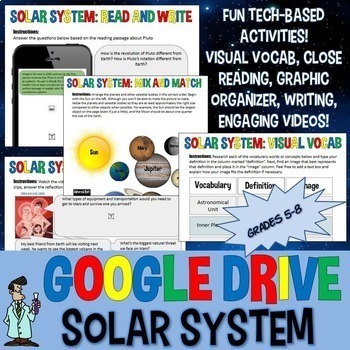Google Drive Solar System Astronomy INB Jr High Science TX TEKS 6.11A 6.11C 7.9A
- Google Drive™ folder

Description
This solar system digital lab for interactive notebooks is a perfect way to incorporate technology into your classroom! This fully editable digital lab incorporates various activities to engage all your learners. I’ve found that setting up stations and having students rotate around the room is great, but time consuming and messy. If you’re looking for a technology based alternative that still has the impact of a gallery walk style lab, this Google Drive lesson is for you! This digital resource is accessed via a link to a set of 7 editable interactive pages covering solar system concepts commonly tested on standardized tests. Accessed via Google Drive or Google Classroom!
Students type their answers directly on the pages, insert images, and drag and drop information for a variety of engaging, interactive activities! This is a fantastic way to integrate technology into your classroom and can be completed without printing any paper if desired! Perfect for classrooms that have a set of tablets or laptops, or a fun activity for computer lab day!
A full answer key for all pages is included along with teacher directions. All you only need is a Google account and you're ready to go!
By using Google Drive or Google Classroom as a platform, this engaging digital lab can be completed totally online on laptops, tablets, or any other device that supports Google Drive!
HOW I’VE USED THE LESSON IN MY CLASSROOM
I use this digital lab as a key component of my solar system unit and for further review of key vocabulary, what a planet needs to support life, rotation, revolution, gravity, components of the solar system, the correct placement of the planets, and reading comprehension practice.
Approximately one to two class periods in length (as a point of reference, I teach a 50-minute class). I generally allow my students to use computers, laptops, or iPads to access the lab and we generally complete all the activities and add the information to their interactive notebooks in two days. Created by Mister Science
YOU MAY ALSO ENJOY
If you’re currently teaching a solar system unit you’ll love my solar system bundle at a HUGE discount! It is a growing bundle, which means that you get future solar system products I add to the bundle FOR FREE!
CHECK OUT THE BUNDLE BY CLICKING HERE
COMMON CORE, NGSS, and TEKS COVERED
This lesson allows you to teach numerous standards covering our solar system in an engaging way.
Addresses many common core and Next Generation Science Standards (NGSS).
This lesson was created for my middle school students and reinforces many English language arts common core standards (such as: “Determine the meaning of symbols, key terms, and other domain-specific words and phrases as they are used in a specific scientific or technical context”). RST6-8.3, RST6-8.4
Next Generation Science Standards (NGSS) addressed in this lesson:
ESS1.B: Earth and the Solar System
The solar system consists of the sun and a collection of objects, including planets, their moons, and asteroids that are held in orbit around the sun by its gravitational pull on them.
This standard is covered when students complete the mix and match assignment to arrange our solar system in the correct order.
For my fellow Texans:
This lab covers the following TEKS:
6.11 (A)
(11) Earth and space. The student understands the organization of our solar system and the relationships among the various bodies that comprise it. The student is expected to:
(A) Describe the physical properties of the planets
This TEK is met when students arrange the planets in our solar system in order and research the physical properties of Mars and Pluto
6.11 (C)
(C) describe the history and future of space exploration, including the types of equipment and transportation needed for space travel.
This TEK is met when students watch a short video and answer questions over the technology being developed to power space transportation in the future.
7.9 (A)
(9) Earth and space. The student knows components of our solar system. The student is expected to:
(A) Analyze the characteristics of objects in our solar system that allow life to exist such as the proximity of the Sun, presence of water, and composition of the atmosphere.
This TEK is met when students watch a short video and answer questions over what it would take to survive on Mars
FEEDBACK AND FOLLOW
Please follow my store! You will receive an email every time I post a freebie, a new paid product, or have a special sale! To follow me, go to the top right of this page where you see my Mister Science drawing, next to the little green star it says “Follow Me”. Click on that and you’ll receive the updates. Thanks for stopping by my middle school science store!
Did you know that you can receive credit towards future TpT purchases by reviewing this product? If you enjoy this product, please leave a review at the product page or through “My Purchases” under “My Account” at TpT. If you have a problem with the lesson PLEASE contact me prior to leaving negative feedback, I will do everything I can to make it right! I want all my fellow teachers who choose me lessons to be happy!
COPYRIGHT INFORMATION
Copyright © Mister Science. All rights reserved by author. This product is to be used by the original downloader only. Copying for more than one teacher, classroom, department, school, or school system is prohibited. This product may not be distributed or displayed digitally for public view. Failure to comply is a copyright infringement and a violation of the Digital Millennium Copyright Act (DMCA). Clipart and elements found in this PDF are copyrighted and cannot be extracted and used outside of this file without permission or license. Intended for classroom and personal use ONLY.
This work is licensed under a Creative Commons Attribution-NonCommercial-NoDerivatives 4.0 International License.





